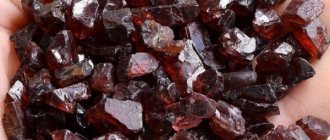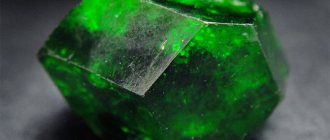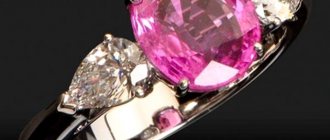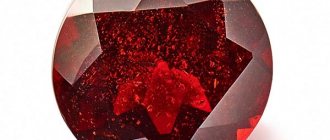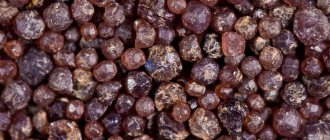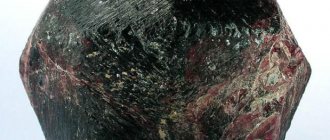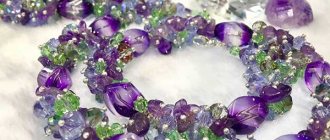- Which: Precious;
- Deposits: Worldwide, except Antarctica;
- Colors: From scarlet to yellow, green and transparent;
- Mohs hardness: 6.5-7.5;
- Transparency: Transparent or translucent;
- Density: 3.47-3.83 g/cm3;
- Formula: R2+3 R3+23;
- Suitable person according to zodiac sign: Everyone;
- How much does it cost: from 1000 rubles per carat.
Garnet stone has been known to people for a long time. Mystical and healing properties were attributed to this precious stone, and, of course, it was widely used in jewelry.
It is one of the twenty most expensive stones in the world and is rightfully considered one of the most beautiful minerals.
History of the origin of the stone
The garnet stone received its modern name in 1270. It was then that the famous alchemist Albert Magnus, describing this rare red mineral, gave it the name “granatus”. This word is related to the term “granules” and literally translated from Latin means “granular.”
Indeed, natural pomegranate occurs in nature in the form of small round granules. Moreover, the size of the unprocessed mineral does not exceed the grains of the tropical fruit of the same name.
In ancient times, each nation gave this gem its own name:
- “Chervets” or “lal” - in Rus'.
- “Bijazi” - in the Arab East (in Russia this word was gradually transformed into “bechet” and quickly took root among the people).
- The Greeks in ancient times called this gemstone “anthrax” - burning coal.
- And the ancient Roman name, also translated as “coal” - “carbuncle” - was used until the 19th century.
History of pomegranate
— Advertising —
The name of the mineral “garnet” was given from the Latin word “bagranurn”, which translates as “grain” or “grain”. Externally, this beautiful gem resembles pomegranate seeds. Also, many synonyms are known for the stone, including: shorlomites, melanites, leucogranates, carbuncles, bechet, scales, venice, Ural stone.
The garnet family includes pyrope, almadine, grossular, and spessartine. The dark red color of pyrope was named in Greek for “like fire.”
Description of pomegranate
Garnet is one of the most worthy rivals of ruby. They are similar both in appearance and in their physical properties (although ruby is a harder mineral). Externally, garnet looks like a transparent or translucent stone with a glassy shiny, very smooth surface.
Garnet patronizes travelers, warriors, lovers, women expecting a child, and people in difficult life situations.
History of the mineral
In the past, all minerals with bright red hues were called "lals". This included not only garnets, but also ruby and spinel. Only after a while the gem was given a separate name. Already in the 16th century, several varieties were known, and until the 19th century, two main names were assigned to them: “bechet” and “venisa” - this is how they tried to distinguish this group of minerals and not confuse it with other stones. It is unclear why the gem was named this way. Perhaps this is due to its appearance, since it is very similar to pomegranate fruits - the same grains, both in shape and shade.
At the beginning of the 17th century, the scientist Boethius de Boot described in his writings on natural minerals that the bloody Bohemian garnet, which was already known at that time, looked like fossilized drops of water that were colored with blood vapor.
Colors and varieties
Most often, when talking about garnet, we mean the classic dark red or, in extreme cases, pink color of this mineral. However, these are far from the only varieties. The color of garnet stone can vary from scarlet to yellow, green and even transparent.
Pyrope
The most common red garnet. Its name comes from the Greek word “pyropos” - like fire. Magnesium and aluminum salts give the stone its peculiar shade.
Almandine
A mineral characterized by a high content of potassium and magnesium. Depending on their concentration, the color can vary from deep red to brown, purple and pink. It is to this variety that the “Bohemian” or “Czech” garnet belongs - a very expensive, almost transparent gem of a light pink hue.
In Rus', almandine, brought from the Arab East, was called “Syrian garnet.”
Grossular
Allumocalcium silicate, the color of which is given by iron ore salts. The very name of this stone comes from the Latin name for gooseberry, which speaks better than any words about the appearance of grossular: small round stones shine in all shades of green and yellow.
Grossular can be:
- light herbaceous;
- orange-yellow;
- dark brown;
- transparent;
- and even an extremely rare sea green color (in mineralogy it bears the name hydrogrossular);
Uvarovite
An extremely rare emerald green garnet found in only a few deposits in the world. It was first discovered in the Urals, in the Saranovsky mine, in 1832 and named after the Russian academician and minister of education, Sergei Uvarov. This stone is often called the “Ural emerald.”
Andradite
This mineral received its name in honor of its discoverer, Jose d'Andrada. In nature, this type of pomegranate has different shades - from yellow and greenish-marsh, to brown and even red. The most popular varieties of andradite are:
Melanitis
An incredibly rare black garnet, characterized by an opaque, matte structure. In fact, this color is a dull dark red, but due to the lack of shine, the stone absorbs almost the entire spectrum of the sun's color, which is why it appears charcoal dark.
Shorlomit
Another type of black garnet, rich in iron salts, thanks to which the edges of the stone have a bright shine with a metallic tint.
Demantoid
An extremely rare transparent gem, distinguished by its light green color. Its name means, literally translated, “like a diamond,” although in appearance it rather resembles an emerald. This mineral is often found in the decoration of Russian palaces of the 18th – 19th centuries.
Spessartine
For the first time, this stone began to be mined in the town of Spessarty, in Germany - this is where the official name of this garnet variety came from. The main colors are yellow, brown, and pink, although there are also examples of a red tint.
Hessonite
Or in other words “essonite”, “cinnamon stone” - garnet of all shades of brown. The most common shades found in nature are yellow, honey, orange, and purple. Occasionally, cinnamon-colored hessonites are found. This is one of the least hard types of pomegranate. Actually, the word “hesson” itself means “weak”, “lesser” in Latin.
Rhodolite
Some mineralologists classify it as a separate group, but in fact it is a hybrid of almandine and pyrope. The high iron content also determines the colors found in this mineral: red and pink in any shade.
Leucogranate
This is the general name for all minerals of this group, distinguished by their transparent color.
Types of pomegranate
The most famous variety of garnets is pyrope.
It has been known to man for a very long time, is considered the oldest of its group, is painted in a deep red color, and looks like pomegranate seeds. Its subspecies are rhodolites - stones of an intense pink or pink-violet hue, reminiscent of alexandrite. Almandines or “carbuncles” are the second type of garnet. They resemble rubies and are colored in dark violet-red or cherry tones.
Honey-yellow or orange-brown color is characteristic of spessartines. These unique minerals are often confused with alexandrites.
Grossulars are painted in a delicate greenish color. Andradites are brownish-brown and burgundy.
Uvarovites, also known as Ural emeralds, can be colorless, pink or green.
Unique demantodids are emerald-herbaceous, have absolute transparency, and are the most expensive of the garnets.
Chemical composition and physical properties
Garnets are silicates with a high content of magnesium, calcium and iron. Depending on the chemical composition, their individual types are classified as both precious and semi-precious, ornamental stones. The general formula of all these minerals looks like this: Mg+Fe+Mn+ +Ca+3Al2[SiO4]3.
At the same time, each subspecies of pomegranate has its own chemical composition. It is the concentration of certain elements that determine the shades of garnet, density and shine.
Despite the number of varieties of stone, its properties in all “varieties” remain approximately the same.
Garnet molecules have a cubic lattice and form either rhombododecahedrons (closed compounds of 12 faces) or tetrahoptrioctahedra (24 faces).
Scientists divide all pomegranates into two main subspecies:
- Pyralspite, which is dominated by iron, magnesium and manganese; form a 12-sided crystal lattice; This is exactly the structure of pyrope, spessarine and almadine.
- Ugrandites, with a high calcium content (as, for example, in uvarovites, grossulars and andradites). The molecules of these gems are formed into tetrahoptrioctahedra.
The hardness of these gemstones ranges on the ten-point Mohs scale from 6.5 (like hessonite) to 7.5 (like pyrite and almandine). Garnet can be easily polished with diamond, but if you run it across glass, it leaves a shallow scratch.
At the same time, it is quite fragile and easily breaks under a strong impact. So processing it is not such a simple matter.
The density of this mineral is low: on average from 3.47 to 3.83 g/cm3.
The surface of the garnet is smooth to the touch, glassy. But the edges of the break, on the contrary, are uneven and rough.
In nature, this gem is found in medium-sized druses. These stones are not large. The largest garnet, a fire pyrope the size of a pigeon's egg, was discovered in Germany and weighed 633 carats.
Physico-chemical characteristics of garnet
Silicates with an island structure - garnets - combine six types of minerals: pyropes (magnesium-aluminum salt), almandines (aluminum-iron salt), spessartines (mangan-aluminum salt), uvarovites (calcium-chromium salt), grossulars (calcium-aluminum salt ), andradites (calcium-iron salt).
Natural garnets also contain inclusions of titanium and vanadium. — Advertising —
According to the color characteristics, there are various garnets, except blue ones. Pyropes are dark red, almandines are pink or cherry, uvarovites are bright green, pink, colorless, andradites are red-brown, brown.
The hardness of the crystals on the Mohs scale is 6.0-7.5. Specific gravity 3.2-4.3 g/cm3. They are transparent or opaque; as a rule, the brighter the color, the less transparent the sample. They have a glassy, resinous or diamond luster.
Place of Birth
Garnets are mined all over the world. Their deposits are found on almost all continents, with the exception of Antarctica. Pomegranates are found in Russia, the USA, Germany, Mexico, Australia, Zambia, Brazil, India, Sri Lanka and some other countries.
In Russia, the largest deposits are located in Yakutia (very rare fiery red pyropes are mined there), on the Kola Peninsula, Chukotka and the Urals. It is the Ural mines that supply jewelers with a significant portion of green uvarovite.
In the USA, on the border of the states of Colorado, Utah, New Mexico and Arizona, one of the most amazing types of this gem is mined: “Ant”, or “Arizona” garnet.
These tiny stones, no more than one and a half carats, are brought to the surface by ants when building their “palaces”. The surprising thing is that, despite all the efforts, it was not possible to detect these bright red granules using the mine method.
Garnet deposits
The most famous garnet deposits are unique placers located in the mountains of the Central Bohemian region, as well as diamond-bearing kimberlite pipes in eastern and southern Africa. Complex deposits of garnets, diamonds and chrysolites were discovered in Yakutia. Certain varieties of pomegranate are also mined in Germany and other European countries.
Who is suitable according to their zodiac sign?
Despite the fact that the magical properties of this stone are in many ways universal, astrologers advise people, before buying jewelry with garnet, to check whether their patron constellation is combined with the magical properties of the “fire” stone.
For those who decide to purchase a garnet stone, their zodiac sign is very important:
- Aquarius: Pyrope and other varieties of red garnets are strictly contraindicated for people born during this period. But hessonite, grossular and uvarovite will give their owner success in matters of the heart, help to remain faithful in separation and strengthen the sense of trust in their “soul mate”.
- For Pisces, this stone is an excellent remedy that helps normalize blood pressure and avoid infections. True, they also cannot carry red grenades.
- Aries: pomegranate is useful for them as a means to cope with temper and avoid quarrels. It also helps in the fight against various phobias.
- Taurus should not buy garnet jewelry.
- Gemini needs to be careful with this stone: it not only gives self-confidence, but also gives rise to passions that are not easy for the ardent nature of Gemini to fight.
- Cancer. For them, pomegranates are contraindicated, with the only exceptions being green varieties.
- For Leos, pomegranate products are useless, although not dangerous.
- This gemstone will help Virgos find harmony and find their path in life.
- Libra: they sometimes need pomegranate as a way to calm their nerves and subdue their impulses.
- For Scorpios, this gem will help moderate their ambitions, achieve peace of mind, and help them reach agreement in love and friendship. At the same time, garnet will help this sign develop their leadership abilities.
- Sagittarius will feel a surge of strength from this gem - both mental and physical.
- Capricorns: pomegranate will help them gain self-confidence, give them strength and insight to make the right decision.
Morphological characteristics (appearance, doubles, etc.)
Currently, geologists know of garnets that have intermediate compositions. They can be divided into several separate types (among which there are also the samples already mentioned above):
- Shorlomite is a mineral from the garnet group, rich in titanium, having a black color and a characteristic metallic sheen.
- Hessonite is a ferruginous grossular characterized by an unusually beautiful and specific red hue.
- Gibsite - contains phosphorus in small proportions, which partially replaces the silicon atomic lattice. In addition, this mineral variety contains water, which is why it belongs to the class of hydrogarnets, including hydrogrossulars.
- Kimtseite is a rock containing up to 20 percent ZrO2.
- Topazolite is andratite of a yellowish-green hue, in the chemical formula of which YAI is replaced by CaSi.
- We will look at the next pair of garnet mineral lookalikes in more detail, since they are considered the most valuable among garnets.
- Tsavorite was first discovered in Tanzania, not far from the national park and the Tsavo River of the same name, which is where it owes its fancy name. This is a very rare garnet found in nature, available in bright green colors. It is usually classified as a transparent variety of grossulars. The first mention of it dates back to the late 60s of the last century - it was during this period that it was discovered and studied by a geologist from Britain, Bridge Campbell, who was working in Africa at that time. He was able to discover this variety of pomegranate in the mountainous areas of northeastern Tanzania. Most often, this mineral is found in the form of crystals from 1 to 5 carats. Tsavorite samples of more than five carats are extremely rare, and therefore jewelry with faceted tsavorite of more than 2 carats is very valuable and is considered a real find. In general, this stone lends itself well to cutting. It has not been discovered in any of the Russian latitudes, but we know quite a lot about it.
- Demantoid is a type of andradite that occurs in nature in a greenish-yellow or pure green, transparent form. It has high light dispersion and distinct shine. Demantoids discovered in the Ural Mountains are mostly rich in asbestos-like inclusions of bissolite crystals of yellow-golden or silver color. These inclusions often have a radial arrangement and a fibrous structure. Such formations or the hollow tubules remaining after their destruction in the rock are called horse tail. The described inclusions can be considered not only a distinctive characteristic feature of demantoids, but also their precious component. For geologists and jewelry makers, their presence is an obvious sign of the natural origin of the stone. In addition, with proper jewelry processing, especially spectacular and beautiful decorative items can be obtained from such rocks. In nature, you can also find demantoids that visually resemble a cat's eye due to the high density of these inclusions. Among garnets, this is perhaps the most valuable mineral. Externally, it is distinguished from other precious stones by its high refractive index, as well as strong dispersion.
Who are the names suitable for?
It is extremely important to determine in advance, when buying a garnet stone, who this type of jewelry is suitable for and who is not. The element of garnets is fire (especially for pyropes and almandines), as well as earth and water. This stone also has patron planets: the Moon, Jupiter, Venus, Mars and the Sun.
Pomegranate is an excellent life talisman for people with the names:
- Alexandra (only for women - for Alexander men this mineral will be useless);
- Alla;
- Anton;
- Valeria;
- Basil
- Galina;
- Lyudmila;
- Maria;
- Nikita;
- and Tamara;
Magic properties
Few stones have as many mystical secrets as the garnet stone - magical properties have been attributed to it since ancient times, and even now many psychics use this mineral in their practices.
Pomegranate has long been considered a symbol of a strong spirit, a pure heart and high spiritual qualities. Therefore, gemologists advise people with weak character to carry garnet with them, so that this mineral will help them develop a strong inner core.
Since ancient times, this mineral personified love and other heartfelt feelings.
According to the medieval “language of stones,” giving a garnet item as a gift meant passionate (perhaps even unrequited) love. It was considered undesirable to wear garnet jewelry in the presence of children or teenagers, since this gem can awaken passions in a person.
At the same time, it was revered as a symbol of marital fidelity. It was believed that pomegranate gives success in love and helps preserve feelings in separation. It was often given to newlyweds as a wedding gift, and to families whose marriage is in danger of destruction, this stone is very useful.
The benefits of green varieties are especially great. Their energy helps strengthen family ties, and for a woman, in addition, serves as an assistant in “women’s concerns.”
The magic of these stones is also associated with the gift of clairvoyance. It is believed that if a pomegranate is dreamed of at night, then soon this person will have to resolve a serious problem or make a difficult choice.
Medicinal properties
The beneficial properties of pomegranate have been known to healers since ancient times.
In lithotherapy, this mineral is used for many diseases:
- inflammation;
- diseases of the respiratory system;
- skin diseases;
- allergies;
- metabolic disorders and endocrine diseases;
- and many other problems.
Legend has it that a garnet set in gold can even get rid of migraines (which modern medicine still cannot cope with).
Garnet stone is extremely useful for pregnant women: it is believed that it makes pregnancy more calm and guarantees an easy birth. In ancient times, jewelry was often made from this gem specifically for pregnant women.
How the stars help the pomegranate
Some advanced lovers of gems and connoisseurs of astrology at the same time give preference to ancient astrologers. Others believe that astrology is a science and should be developed.
In any case, it is important to choose “your” stone.
In ancient times, astrologers assured that people with a strong planet Mars could wear garnets. They allowed products with pomegranate for Scorpios, Virgos and Aquarius.
Modern astrologers believe that members of the garnet family have different properties. Therefore, compatibility with a stone according to the zodiac sign is not always determined by the usual laws of astrology. In many cases, it is necessary to determine whether a gem is suitable simply by the “poke method”.
Pendant with garnet
Different types of pomegranate have different effects on representatives of different zodiac signs.
We recommend: RHODOLITE - scentless rose
For Sagittarius, the gem will give power over people, drive away sadness, and bring joy.
According to the zodiac, Hessonite is suitable for Fire signs. The longer the owner of the stone wears the jewelry, the stronger the connection between the gem and the person. The wise East has always believed that hessonite gently rids its owner of illusions and misconceptions. In matters of the heart, the gem is the first assistant. The effect of the stone is always soft, delicate, unobtrusive.
Pyrope and all red garnets are good for Sagittarius and Leo.
It will not become a talisman for Taurus and Pisces.
Green garnets (tsavorite, jelletite, uvarovite and grossular) will be good companions for Scorpios, Virgos, Cancers.
According to the horoscope, the stones will become talismans for those born in January.
Important: garnet jewelry can strengthen weak Mars in the natal chart.
Talismans and amulets
Since ancient times, people have used amulets made from this gem.
For example, every traveler tried to take a garnet ring or pendant on the road. The pomegranate is considered an amulet that can both preserve and win the love of another person. Scandinavian legend says that the miniature Ogren, having fallen in love with Freya, the goddess of love, forged a beautiful necklace in order to achieve her favor.
Another property attributed to pomegranate is especially important for men. It symbolizes masculinity, fortitude, and courage.
Many warriors wore jewelry made from this mineral, as it was considered a strong amulet that protected against wounds and death in battle. They inlaid weapons, armor, and helmets. And during the Crusades, almost every knight had a ring with a garnet, designed to protect it in battle.
Products made from garnet have very strong energy, because of this you should not wear it continuously, you should remove it from time to time and let it “rest”.
Structural characteristics
Garnet has a cubic type system in the hexoctahedral manifestation of natural symmetry. The structure of garnet samples is represented by SiO4 groups isolated from each other with a helical arrangement along the fourth-order axis. Due to this, the habit of the crystal acquires tetragontrioctahedral and rhombododecahedral characteristics. In this case, the rhombic dodecahedral type predominates for the calcium series, and for the aluminum series, the predominance is observed at the level of the tetragontrioctahedral habit. Presumably this is due to a change in the ratio between tri- and divalent cations.
Other uses of stone
Garnets were often present in the ceremonial clothes of courtiers, in the outfits of noble people, and even in the decoration of palaces. For example, the Chamber of Facets in the Kremlin is entirely inlaid with this very mineral. The famous jeweler Faberge was very fond of this mineral: many of his boxes and precious toys were made using garnet fragments.
These gemstones are widely used in various industries. Thus, garnet is an excellent ferromagnet, which is why it is used in electronics. It is also added to some building mixtures. Parts of optical systems and lasers can be made from this mineral (as well as from ruby).
How is garnet formed?
Garnet crystals occur in igneous rocks - schists and gneisses. In the case of crystalline slate, garnet (and in this particular case, almandine) is the rock-forming mineral. Its companions are often micas, chlorite and disthene. In this case, the origin of the mineral is metamorphic.
The second option for the formation of these semi-precious gems is the contact process, otherwise called skarn. For the formation of such types of minerals as grossular and andradite, contact of the rock with limestone rocks, rhodolites, eclagites, etc. is necessary.
In skarns, garnet is accompanied by sulfites of iron, copper and lead, as well as salite, vesuvian, scheelite, etc. Garnets are often part of igneous rocks, such as peridotites and kimberlites, granite, and appear on the surface due to the activity of volcanoes.
Natural garnet is a very resistant material, therefore, when the rock weathers, this gem is not subject to destruction, but turns into placer.
Price
Garnet, despite its beauty, is not a very expensive stone.
The price of garnet stones depends on the quality and size and, of course, on the rarity of the color:
- Almandine can be bought for 1900 rubles per 1 carat.
- Rhodolite – 1700 rubles.
- The cost of pyrope starts from 1170 rubles.
- Spessartine is considered one of the most expensive garnets. For example, a specimen weighing 4.7 carats is estimated at 35 thousand rubles.
But the price of a technical quality garnet stone starts from a few dollars per carat - for example, Nigerian stones for industry can be bought for 150-600 rubles per carat.
Many jewelry and handmade websites provide summary tables that indicate the price (in rubles and dollars) for different types of garnet. So, earrings with a garnet stone in a gold frame can be bought starting from 7,000 rubles.
Application
The scope of application of pomegranate is extensive. Due to its ability to split into sharp crystals, raw garnet is used in the abrasive and construction industries (in the form of additives to cement mortar).
The natural mineral is successfully used as a replacement for expensive rubies and sapphires in instrument making, and is also used in ferromagnets due to its magnetic sensitivity and high conductivity.
In ancient times, ornamental garnet was used as a basis for cameos and figurines depicting gods. Then the mineral began to be processed in the form of cabochons, much later, transparent garnets of beautiful and rich colors began to be cut and actively used as jewelry. This stone gained particular popularity only in the 19th century.
Rhodolite, a type of garnet, is widely used in jewelry. High-quality crystals lend themselves well to cutting; after processing, such rhodolite most often acquires a round cut, as well as oval and stepped edges. Low quality stones are used as cabochons. Rhodolite is equally popular as jewelry among both men and women. Rhodolite most often has pink shades, and its price rarely exceeds 1,500 rubles, but gems with an alexandrite effect are valued even higher. Andratite is used no less often than rhodolite in jewelry. Due to the variety of varieties and shades, this type of pomegranate has gained great popularity. Of particular interest is the rare black andradite, which looks most elegant in silver. Descriptions of jewelry with it can be found in memoirs and novels of the 19th century; it was then that black stones became very popular, as mourning fashion was actively developing.
Garnet druses and brushes rarely find practical use; much more often the unprocessed gem in this form can be found in private collections or museums.
Care
Garnets are capricious minerals. They need to be stored in a dark, fairly cool (but not cold!) place. Each stone must be placed separately or wrapped in a piece of cloth. Separate boxes are required for jewelry made from these gems.
You can clean a garnet jewel with a soft brush. To do this, you need to fill the stones with water for a while, and then carefully wash them with soapy water.
Useful components
Pomegranate is a real storehouse of nutrients. But among them there are two, perhaps the most important - punicalagins and punic (or pomegranate) acid. Punicalagins are powerful antioxidants found in pomegranate juice and peel. Their effectiveness is 3 times higher than the beneficial properties of red wine and green tea. Pomegranate acid is mainly concentrated in the peel of the fruit and also has powerful biological properties [2].
Researchers estimate that pomegranates contain more than a dozen beneficial polyphenols, which makes the juice from these fruits much healthier than a drink made from grapes or blueberries.
This healthy fruit contains almost no calories (100 g contains a little more than 80 kcal), which is almost identical to the calorie content of an apple [3].
It contains no cholesterol or saturated fat, but is an excellent source of soluble and insoluble fiber (providing approximately 12% of the daily value). It is a good source of vitamin C, making it useful as an immune booster. Regular consumption of the fruit provides the body with vital B vitamins, as well as many macro- and microelements [4]. Nutritional value per 100 g [5]
| Calorie content | 83 kcal |
| Squirrels | 1.7 g |
| Fats | 1.2 g |
| Carbohydrates | 19 g |
| Cellulose | 4 g |
| Thiamine (B1) | 0.07 mg |
| Riboflavin (B2) | 0.04 mg |
| Niacin (B3) | 0.3 mg |
| Pantothenic acid (B5) | 0.15 mg |
| Pyridoxine (B6) | 0.09 mg |
| Folic acid (B9) | 39 mcg |
| Vitamin C | 10 mg |
| Vitamin E | 0.8 mg |
| Vitamin K | 16.5 mcg |
| Potassium | 235 mg |
| Sodium | 3.2 mg |
| Calcium | 12 mg |
| Iron | 0.35 mg |
| Copper | 0.16 mg |
| Manganese | 0.13 mg |
| Magnesium | 11 mg |
| Zinc | 0.32 mg |
| Phosphorus | 33 mg |
| Selenium | 0.4 mcg |
What stones does it go with?
It’s rare that anyone has jewelry sets made from the same material. Much more often, people choose jewelry to match their outfit and hairstyle from different items. Pomegranate is quite whimsical in this regard.
It goes well with stones such as:
- emerald;
- sapphire;
- agate.
But it is better to keep diamonds, pearls, lapis lazuli, turquoise, moon pearls, chrysolites and chrysoprase away from garnets.
How to choose and store pomegranate correctly
It is believed that the most delicious fruits grow in the southern regions of Afghanistan. Ripe fruit is easily recognized by the bright crimson color of its peel, and when tapped with a finger, it makes a metallic ringing sound. Overripe fruits become very hard on the outside and inedible on the inside. Spotted fruits may be hard and bitter. Also, you should not take pomegranates that are moldy, cracked, or wrinkled, and soft fruits are usually rotten inside.
You can store ripe fruits at room temperature for longer, but in the refrigerator they will remain fresh for several weeks. In general, pomegranates have a fairly long shelf life.
How to distinguish from a fake?
Like other gemstones, garnet has many features that can distinguish it from counterfeits or artificial substitutes.
There are several ways to identify a real garnet:
- Take the stone to a jewelry store and ask for expert advice.
- You can distinguish a garnet from a fake by rubbing it with a woolen cloth. Natural stone quickly becomes electrified - you can check this by passing it past fluff or your own hair.
- Garnet has minor magnetic properties. You can check this using small metal shavings.
- Another way to check the authenticity is to swipe it on the glass. Natural stone should leave a thin scratch on the glass.
How to clean
The average pomegranate contains approximately 1,300 grains. But anyone who has ever tried to separate this fruit knows how difficult it is not to damage them and not to splash themselves with bright red juice. However, there is an easy way to cut pomegranates. At the same time, it guarantees clean hands, clothes, kitchen and cutting board.
To do this, you will first need to cut off the “crown” of the fruit, and then make several cuts along the peel from the place of the “crown” along the fruit. And now the biggest trick: fill a pan with water and put the pomegranate in the water. Already under water, gently stretch the peel with your fingers so that the grains spill into the water. Then drain the liquid and blot the pomegranate seeds with a paper towel.
Artificial pomegranate
Natural garnet is not such a rare mineral. However, modern scientists are making many attempts to “grow” these stones under artificial conditions. This is how the synthetic silicate, cubic zirconia, was created. It was raised in the USSR in 1968 for the needs of nuclear energy.
cubic zirconia
This gem is distinguished by a variety of colors that natural garnets cannot boast of: for example, cubic zirconia is known for its incredible lavender hue - but in nature blue color is impossible for these minerals.
About the minerals of the garnet family
Minerals of the garnet familyGarnets are a large group of minerals from the class of silicates with isolated tetrahedra that are similar in structure and properties. The name is given due to the similarity of some of them to pomegranate fruit seeds. The general formula is R2+3R3+2(SiO4)3, where R2+ = Ca, Fe, Mg, Mn, and R3+ = Al, Fe, Cr, Mn. Garnets provide an excellent example of the ease with which certain elements can replace each other without disrupting the crystal structure. Despite the apparent complexity of their chemical composition, all garnets are described by the same formulas. Calcium, magnesium, ferrous iron and manganese, on the one hand, aluminum, ferric iron and chromium, on the other, can replace each other within wide limits, and in nature it is rare to find a real garnet, the composition of which would exactly correspond to one of the following formulas
• End members of the group The following representatives of the garnet group are independent mineral species: •• Pyrope Мg3Аl2(SiO4)3 (name from the Greek pyropos - fire-like). It almost always contains a fairly large admixture of ferrous iron, which approaches the composition of almandine, so it is not always possible to make a sharp distinction between these two varieties. Pyrope can have different colors, but more often it has a ruby-red or crimson color, sometimes with a purple tint, especially if it is close in composition to almandine. But the color of pyrope is due not only and not so much to iron as to chromium. The fact that the color of pyrope is determined by chromium is emphasized by the great similarity of the color of pyrope to the color of ruby, and this in turn indicates the connection of pyrope with ultramafic rocks and its depth. Stones with a yellowish tint have much lower jewelry and collection value. The variety rhodolite received its name from the Greek. “rose-colored stone” in connection with the specific pink color.•• Almandine Fe3Al2(SiO4)3•• Spessartine Mn3Al2(SiO4)3 (named from the Spessart plateau in Bavaria, Germany) •• Grossular Ca3Al2(SiO4)3 (name from the Latin grossularia - gooseberry, due to its resemblance to gooseberry fruits) •• Andradite Ca3Fe2(SiO4)3•• Uvarovite Ca3Сr2(SiO4)3 Part of the chromium in uvarovite is always replaced by aluminum. Named in honor of Count S.S. Uvarov, President of the St. Petersburg Academy of Sciences. The bright color of uvarovite is due to the presence of chromium; uvarovite has a high refractive index (1.87) with a relatively low density (~3.77). Unlike related varieties of garnets, uvarovite does not melt in the flame of a conventional blowpipe. Minerals of the garnet group are solid solutions of mainly any two minerals. They are named, as a rule, by the predominant mineral, but sometimes have their own names, for example, rhodolite - a mixture of pyrope with almandine or ferrous pyrope, ferrospessartine - a mixture of spessartine with almandine, hessonite - grossular with andradite; demantoid - andradite with uvarovite or chromium-containing andradite. Due to the same crystal structure and the similarity of many properties, all minerals of the garnet group are characterized together. The hypothetical members of the garnet series are not found in pure form, but may form a significant proportion in natural minerals.
• Varieties The following garnets with an intermediate composition are known, classified as varieties:•• Hessonite - Fe-grossular of a specific beautiful red color •• Melanite - Ti-andradite with isomorphic replacement of NaTi by CaFe3+•• Shorlomite - a variety highly enriched in titanium, black in color and with a metallic luster•• Demantoid is a transparent green to greenish-yellow variety of andradite, with high luster and light dispersion. Ural demantoid rocks are characterized by radially located fibrous inclusions of golden-yellow bisolite crystals in almost every stone or hollow channels (“horsetail”) left from its destruction. These inclusions are not only typical for demantoid, but can even increase its price. There are demantoids with a “cat’s eye” effect, which is created in some grains due to the abundance and dense arrangement of inclusions. Demantoid is the most valuable of the garnets. It is easily distinguished from other green gemstones by its high refractive index, lack of birefringence and strong dispersion.•• Topazolite - transparent yellowish-green andradite, yttrium garnet with YAl replaced by CaSi•• Kimzeite - with a ZrO2 content of about 20%•• Gibsite - with a certain amount of phosphorus replacing some of the silicon atoms and containing water (hydrogenates, especially hydrogrossular). •• Tsavorite - (named after the place of discovery near the Tsavo National Park and the Tsavo River, Tanzania) - a rare bright green garnet of different shades, a transparent variety of grossular. First found in Africa in 1967 by British geologist Campbell Bridge in the mountains of northeastern Tanzania. Crystals up to 1-5 carats are numerous, and those weighing more than five carats are very rare, therefore faceted tsavorite larger than two carats is rare. A moderately expensive jewelry stone that lends itself well to cutting. Not found in Russia, but already known quite well.
• Crystal chemical characteristics Cubic system, hexoctahedral type of symmetry. The structure of garnets consists of isolated groups (SiO4) located along a fourth-order helical axis. This explains the rhombododecahedral and tetragontrioctahedral crystal habit inherent in garnets, and the change in the ratio between divalent and trivalent cations may apparently be responsible for the predominance of the rhombododecahedral appearance for the calcium series of garnets, and the tetragontrioctahedral for the aluminum series. Based on the nature of isomorphic substitutions, the following are distinguished: •• I. (Mg, Fe, Mn) AI-garnets, called pyralspites; •• II. (Al, Fe, Cr) Ca-garnets, called ugrandites. Continuous series have been established: pyrope - almandine, almandine - spessartine, grossular - andradite and andradite - uvarovite. There is no complete isomorphic miscibility between Al-garnets and Ca-garnets.
• Properties The color of minerals of the garnet family varies to anything except blue. The luster is glassy, greasy, up to diamond. Transparent or translucent. The color of the line is white or light grey. Hardness 6.5 - 7.5. Fragile. Density 3.5 - 4.3. There is no cleavage, sometimes there is separation. The fracture is uneven to semi-conchoidal.
• Forms of occurrence in Nature Crystals are common and varied, often well-formed single crystals, mainly rhombic dodecahedrons and tetragontrioctahedra. Characterized by rough shading on the edges. Often in the form of intergrowths, drusen and crystalline brushes. Also isometric grains, metacrystals, dissemination, granular aggregates.
• Origin Common in igneous and contact-metasomatic deposits. In deposits associated with metamorphic crystalline schists, gneisses and amphiboles. Some of the garnets may be rock-forming minerals. Aluminum garnets (pyralspites) are mainly of igneous origin. Pyrope occurs in ultramafic rocks and is formed only under high pressure conditions; it is characteristic of some peridotites, kimberlites, and serpentinites. Shorlomite - in nepheline syenites, almandine and spessartine in granites and especially in granite pegmatites. Spessartine is found in granitic pegmatites (gem-quality crystals are found in rare-metal pegmatites), in metamorphic rocks and manganese-rich skarns, and almandine is also typical for regionally metamorphosed alumina-bearing sediments, in which it often forms porphyroblasts, sometimes due to staurolite, and is common in crystalline shales and in gneisses.. In the western part of Norway, garnet porphyroblasts with a diameter of up to 1 meter were found in amphibolites. Calcium garnets are typical metasomatic products in calcareous rocks. Grossular associates with other calcium silicates, such as vesuvianite, wollastonite, diopside, scapolite, etc., it is characteristic of thermally and regionally altered calcareous rocks (calcareous skarns) and is usually a product of calcium metasomatism. Andradite is formed during contact-metasomatic and metamorphic processes, often found in skarns in the form of individual well-formed crystals of rhombic dodecahedral or tetragontrioctahedral appearance (with characteristic shading on the faces) or forms intergrowths, druses, crystalline crusts in cracks and voids in association with magnetite, epidote , chlorites, pyrite, quartz, calcite. Uvarovite is commonly found in association with Cr-spinels and Cr-chlorites in Alpine-type voids and fissures as a product of pneumatolitic-hydrothermal processes in chromite-bearing ultramafic igneous rocks. Garnets are resistant to weathering, which is why they are widely distributed in placers. However, with very intense weathering, ferruginous garnets can decompose to form limonites, and manganese garnets can be replaced by manganese hydroxides.
• Deposits Numerous and varied. Thus, pyrope in Russia is widely known in kimberlites (where it is a companion of diamond) and in eclogites of Yakutia. Pyrope, like diamond, is formed under high pressure conditions and is confined to the deepest rocks of the earth’s crust - kimberlites. The first diamond-bearing kimberlite pipe in Yakutia was found by tracing the distribution of pyrope in the river alluvium. Pyrope is a constant companion of diamond, and is often mined in parallel with diamond. The best known pyropes are from deposits in the Czech Republic, where they are present in fragments of basaltic breccia included in peridotites and are mined from placers; a study of Czech deposits showed that they are also confined to a kimberlite pipe, but not a diamond-bearing one. Massive mining of pyrope (“Cape rubies”) in South Africa has virtually eliminated the production of jewelry pyrope in the Czech Republic. Until recently, demantoid was known only in Russia and was discovered in 1874 in the placers of the Bobrovsky deposit in the Middle Urals, near Yekaterinburg. Its primary deposit was also discovered there. Jewelry-quality specimens mined there are very highly valued, but rarely exceed 5-10 mm in size. Most Ural demantoid rocks are characterized by thin fibrous inclusions of bissolite, sometimes creating a “cat’s eye” effect in them. Green garnet, similar in composition and properties to demantoid, was found in the 1990s. in primary deposits in Namibia and Iran. But Ural demantoids are valued more expensive than similar green garnet from other deposits. A demantoid-like green gem-quality garnet called tsavorite was discovered in 1967. in Africa and is mined in Tanzania and Kenya (little known in Russia). Uvarovite was first discovered in the Urals; remarkable brushes of uvarovite on chromite have been coming in large quantities since 1957 from the Saranovskaya-Rudnaya mine of the Saranovsk deposit, discovered in 1889; later also found in the Pyrenees, the Himalayas and Silesia. The sizes of individual crystals in uvarovite in brushes usually do not exceed 1 mm, and samples with crystals from 3 mm. and more are considered unique. • Application Transparent varieties of some garnets are classified as precious stones (pyrope, almandine, demantoid, tsavorite). Uvarovite, despite its juicy green color and high hardness, is not used in jewelry, since it never produces large enough crystals that could be cut. Pyropes and almandines have been known and valued since ancient times. Thus, the red garnet was one of the Old Testament “sacred stones”, mentioned in the Bible under the name “carbuncle” - one of the 12 stones that adorned the breastplate of the High Priest. Nowadays, garnets are increasingly mined specifically as a decorative and collection material in the form of spectacular crystals, druses and crystal brushes. Attempting to stimulate the trade of stones by giving them pretentious names that do not reflect what the stones really are is highly reprehensible, and garnet names such as "Cape ruby", "Arizona ruby", "Colorado ruby", "Adelaide ruby" and “Candy-spinel”, often referred to as pyropes mined at various deposits, is incorrect. For example, the so-called "Ely-rubies" are pyropes from the area of Ely Ness in Scotland. Among the unique garnets that have gone down in history, star almandine weighing 174 carats (34.8 grams) is stored in the Smithsonian Institution in the USA (mined in Idaho), and a marvelous pyrope weighing 468.5 carats (93.7 grams), adorning the Order of the Golden Rune of the Saxon kings. From an astrological point of view, garnets are stones of the planet Mars, so they are good for fire signs of the Zodiac, but Aries are shown less than others. Some of the garnets (eg pyrope) can be worn by Scorpio and Taurus, but only from time to time. This stone is contraindicated for Virgos, Pisces, Cancers, and Capricorns. But in each specific case you should look at the variety of garnet, and if for pyrope there may be some recommendations, then for almandine or demantoid there are completely different ones. Since ancient times, pomegranates have been surrounded by many legends and tales about their extraordinary magical properties. Thus, it was believed that, along with many other precious stones, the garnet “saves its owner from troubles and illnesses,” “gives power over people,” or “is capable of bringing good luck.” A stolen garnet, on the contrary, like a diamond, is “dangerous and brings misfortune, loss of reason, money and health.” Nowadays, arguments about the “healing properties” of minerals have become common, in particular, that wearing red garnets supposedly “strengthens the family, promotes conception and facilitates childbirth” and “helps treat ulcers, flatulence, constipation, impotence,” and green ones “ helps to reveal intuition and talents, develop the mind and strengthen memory, get rid of depression and nightmares.” But, without scientific evidence, such judgments are subjective in nature and are already in the realm of everyday beliefs, so whether to take this seriously or not is everyone’s free choice. At the same time, one cannot fail to note the beneficial and calming effect that comes from observing beautiful crystals or works of jewelry.
